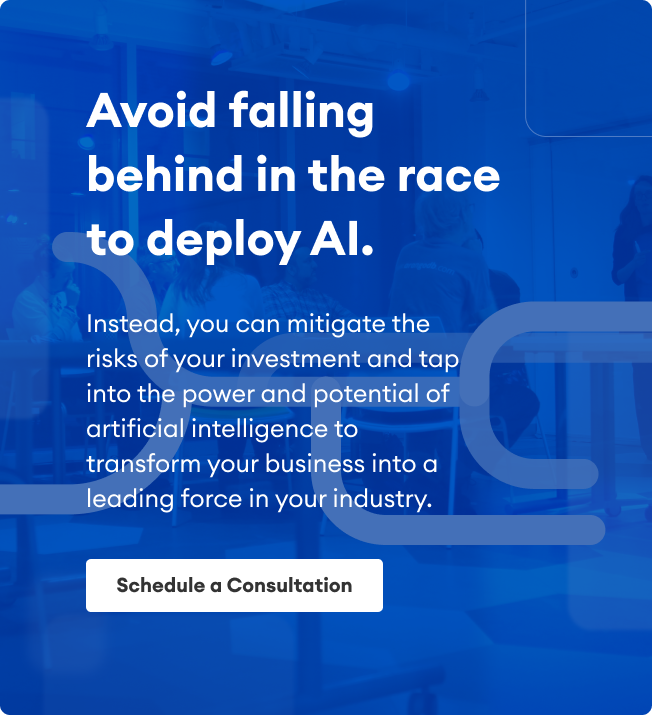Reason #1: Threat of a Competition (aka Outrun the Bear)
Where workers do lose their jobs due to automation, it may not be because they themselves are replaced by some piece of software. It’s often because the firms they work for fail. And the firms they work for fail because their management is unwilling or unable to keep up with the new possibilities of technology. That failure often extends to failing to invest in the training that their employees need to implement the latest technologies.
When it comes to whether to adopt AI, it is helpful to think of the story of two friends, Tom and Amy, hiking through the forest. They stop for a break, taking off their shoes to let their feet breathe. As they relax, they spot a grizzly bear approaching them. Amy silently starts to slip on her shoes. Tom says, “You’ll never outrun that bear. Why bother putting on your shoes?” “Well,” says Amy, “I don’t have to outrun the bear. I only have to outrun you.” And then she sprints off.
If a firm is like Amy — that is, it is able to move quickly to adapt to the changing market — it may well thrive and grow in the age of automation, hiring more workers. However, if firms or organizations misread the nature of changes brought on by AI, their employees will get eaten by the bear.
This pressure has only increased since COVID. According to the Harvard Business Review
- Fifty-two percent of companies accelerated their AI adoption plans because of the Covid crisis, a study by PwC finds. Just about all, 86%, say that AI is becoming a “mainstream technology” at their company.
- Most executives (74%) not only anticipate AI will deliver more efficient make business processes but also help to create new business models (55%) and enable the creation of new products and services (54%).

Reason #2: Growth with Digital Workers
Over and over again, entrepreneurial leaders get stuck. They’ve made great progress in growing a business from scratch.
On the surface, the business looks fine, maybe even booming.
Underneath, there are serious problems.
The owner is constantly over-stretched, wishing they had more people to delegate work to.
Employees are overworked, and unable to take on new work.
It would be wonderful to add new employees, but finding and retaining them is so hard.
When the pain becomes strong enough, owners start turning their mind to intelligent automation. They get excited by the possibility that the work of their teams can be supplemented by a cadre of Digital Workers who can:
- Increase process efficiency. Bots can work more consistently and quickly than people for a range of tasks.
- Make use of data in more useful and creative ways than a person can. AI can see connections in data that a person can’t.
- Find new ways to meet customer demands. It is not just the same work done faster. It is work getting done in ways that would not be possible without automation, that customers prefer.
- Free their existing employees to take on other tasks they prefer, such as building relationships with customers.
Importantly, the best companies don’t look at this as a way to reduce the number of employees, but to increase the amount of work that gets done. Work gets automated, and then employees are called upon to learn new tasks and devise new ways to satisfy customers so that the business keeps growing.
As Azeem Azar notes in The Exponential Age, companies that have invested the most in automation, are the ones increasing their employee count. The truth is that many parts of a job that AI will not replace. A workplace manual is usually barely even a rough guide to what a job is — it doesn’t cover half of the things you need to be successful. Without clear rules, it is hard to build an AI. Therefore, it makes more sense to think about AI taking on the tasks it is well-suited for, and freeing up your employees for matters beyond the ability of an AI.
Reason #3: Competitive Advantage from Fast Learning
Sometimes people define AI in terms of scale, referring to data as the “new oil”— maybe because oil is an input, and the more of it you have, the better. But these points miss that what is different about AI is the competitive advantage that comes from fast learning.
To understand how different AI is, step back and think of the evolution of tools in three waves.
In the first wave, we developed tools that gave us physical leverage. Think of needles that made it easier to make clothing.
In the second wave, we gained intellectual leverage. Think of printing presses and computers that allowed us to gather more information and make calculations beyond our ordinary intellectual reach. Clothing patterns could be transferred automatically to machines manufacturing the clothing, saving considerable time and effort.
We are now in the third wave of AI, which gives us decision-making leverage. AI allows us to go beyond using computers to do the same job, like manufacturing clothing, more efficiently. AI allows us to work in new ways, and create clothing that we would never have created. AI can, for example, scan images on social media and suggest entirely new designs to manufacture. Over time, the AI can learn which designs will work best, how many to make and when to sell this.
As Ash Fontana says, in the AI First Company, learning fast is the basis of a new competitive advantage. He calls it data learning effects: the automatic compounding of information.
While not everyone uses the exact same terminology, he says to think about there being a difference between data and information. Data are facts and statistics. Having a big bucket of data can be a competitive advantage. For example, when selecting a vendor of phone numbers for sales targets, go with the vendor that has the most phone numbers. However, more data only makes a product useful up to a point.
Data becomes useful information when it is refined. Fontana puts it this way: information is data that resolves uncertainty for a decision-maker. It can be used to change someone’s mind.
What AI first companies do is turn data into useful information that helps answer questions such as “How much should we charge for our insurance offering?” or “When will my bakery run out of flour?”
AI accelerates this process with positive feedback loops. The cycle looks like this: You feed data into an AI, and it becomes more effective. For example, Netflix is made better by recommending movies to you. This improved service becomes more desirable, and so more of us use it. As more of us use it, we generate more data about our tastes and preferences. That data can then be fed into the AI, which gets smarter, and the product improves.
To put it more concretely, the steps to building a data learning effect with intelligent machines are:
- capturing a critical mass of data,
- developing capabilities to process that data into useful information, and
- feeding that useful information into a computer that runs calculations over data to learn something new.
Visionary leaders realize this new wave of developments will change the way they operate. In the past, companies had to effectively manage land, labour and capital. Tomorrow’s companies will need to excel at managing information.


